p47 GTPases regulate Toxoplasma gondii survival in activated macrophages
- PMID: 15908352
- PMCID: PMC1111824
- DOI: 10.1128/IAI.73.6.3278-3286.2005
p47 GTPases regulate Toxoplasma gondii survival in activated macrophages
Abstract
The cytokine gamma interferon (IFN-gamma) is critical for resistance to Toxoplasma gondii. IFN-gamma strongly activates macrophages and nonphagocytic host cells to limit intracellular growth of T. gondii; however, the cellular factors that are required for this effect are largely unknown. We have shown previously that IGTP and LRG-47, members of the IFN-gamma-regulated family of p47 GTPases, are required for resistance to acute T. gondii infections in vivo. In contrast, IRG-47, another member of this family, is not required. In the present work, we addressed whether these GTPases are required for IFN-gamma-induced suppression of T. gondii growth in macrophages in vitro. Bone marrow macrophages that lacked IGTP or LRG-47 displayed greatly attenuated IFN-gamma-induced inhibition of T. gondii growth, while macrophages that lacked IRG-47 displayed normal inhibition. Thus, the ability of the p47 GTPases to limit acute infection in vivo correlated with their ability to suppress intracellular growth in macrophages in vitro. Using confocal microscopy and sucrose density fractionation, we demonstrated that IGTP largely colocalizes with endoplasmic reticulum markers, while LRG-47 was mainly restricted to the Golgi. Although both IGTP and LRG-47 localized to vacuoles containing latex beads, neither protein localized to vacuoles containing live T. gondii. These results suggest that IGTP and LRG-47 are able to regulate host resistance to acute T. gondii infections through their ability to inhibit parasite growth within the macrophage.
Figures
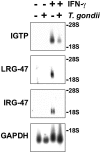
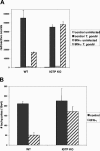
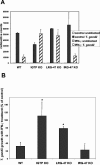


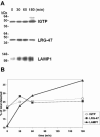

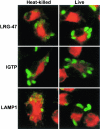
Similar articles
-
The IFN-γ-inducible GTPase, Irga6, protects mice against Toxoplasma gondii but not against Plasmodium berghei and some other intracellular pathogens.PLoS One. 2011;6(6):e20568. doi: 10.1371/journal.pone.0020568. Epub 2011 Jun 17. PLoS One. 2011. PMID: 21698150 Free PMC article.
-
The function of gamma interferon-inducible GTP-binding protein IGTP in host resistance to Toxoplasma gondii is Stat1 dependent and requires expression in both hematopoietic and nonhematopoietic cellular compartments.Infect Immun. 2002 Dec;70(12):6933-9. doi: 10.1128/IAI.70.12.6933-6939.2002. Infect Immun. 2002. PMID: 12438372 Free PMC article.
-
Gamma interferon-induced inhibition of Toxoplasma gondii in astrocytes is mediated by IGTP.Infect Immun. 2001 Sep;69(9):5573-6. doi: 10.1128/IAI.69.9.5573-5576.2001. Infect Immun. 2001. PMID: 11500431 Free PMC article.
-
Decoding Toxoplasma gondii virulence: the mechanisms of IRG protein inactivation.Trends Parasitol. 2024 Sep;40(9):805-819. doi: 10.1016/j.pt.2024.07.009. Epub 2024 Aug 20. Trends Parasitol. 2024. PMID: 39168720 Review.
-
p47 GTPases: regulators of immunity to intracellular pathogens.Nat Rev Immunol. 2004 Feb;4(2):100-9. doi: 10.1038/nri1270. Nat Rev Immunol. 2004. PMID: 15040583 Review.
Cited by
-
Secretion of Rhoptry and Dense Granule Effector Proteins by Nonreplicating Toxoplasma gondii Uracil Auxotrophs Controls the Development of Antitumor Immunity.PLoS Genet. 2016 Jul 22;12(7):e1006189. doi: 10.1371/journal.pgen.1006189. eCollection 2016 Jul. PLoS Genet. 2016. PMID: 27447180 Free PMC article.
-
Interferon-gamma- and perforin-mediated immune responses for resistance against Toxoplasma gondii in the brain.Expert Rev Mol Med. 2011 Oct 4;13:e31. doi: 10.1017/S1462399411002018. Expert Rev Mol Med. 2011. PMID: 22005272 Free PMC article. Review.
-
Regulation of macrophage motility by Irgm1.J Leukoc Biol. 2010 Feb;87(2):333-43. doi: 10.1189/jlb.0509299. Epub 2009 Nov 17. J Leukoc Biol. 2010. PMID: 19920210 Free PMC article.
-
Interactions of Autophagy and the Immune System in Health and Diseases.Autophagy Rep. 2022;1(1):438-515. doi: 10.1080/27694127.2022.2119743. Epub 2022 Oct 5. Autophagy Rep. 2022. PMID: 37425656 Free PMC article.
-
The p47 GTPase Lrg-47 (Irgm1) links host defense and hematopoietic stem cell proliferation.Cell Stem Cell. 2008 Jan 10;2(1):83-9. doi: 10.1016/j.stem.2007.10.007. Cell Stem Cell. 2008. PMID: 18371424 Free PMC article.
References
-
- Boehm, U., L. Guethlein, T. Klamp, K. Ozbek, A. Schaub, A. Futterer, K. Pfeffer, and J. C. Howard. 1998. Two families of GTPases dominate the cellular response to IFN-γ. J. Immunol. 161:6715-6723. - PubMed
-
- Carlow, D. A., J. Marth, I. Clark-Lewis, and H.-S. Teh. 1995. Isolation of a gene encoding a developmentally regulated T cell-specific protein with a guanidine nucleotide triphosphate binding motif. J. Immunol. 154:1724-1734. - PubMed
-
- Collazo, C. M., G. S. Yap, S. Hieny, P. Caspar, C. G. Feng, G. A. Taylor, and A. Sher. 2002. The function of gamma interferon-inducible GTP-binding protein IGTP in host resistance to Toxoplasma gondii is Stat1 dependent and requires expression in both hematopoietic and nonhematopoietic cellular compartments. Infect. Immun. 70:6933-6939. - PMC - PubMed
-
- Collazo, C. M., G. Yap, G. D. Sempowski, K. D. Lusby, L. Tessarollo, G. F. Vande Woude, G. F., A. Sher, and G. A. Taylor. 2001. Inactivation of LRG-47 and IRG-47 reveals a family of interferon-γ-inducible genes with essential, pathogen-specific roles in resistance to infection. J. Exp. Med. 194:181-187. - PMC - PubMed
Publication types
MeSH terms
Substances
Grants and funding
LinkOut - more resources
Full Text Sources
Other Literature Sources
Molecular Biology Databases
Miscellaneous

